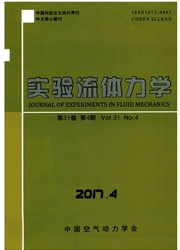

 中文摘要:
中文摘要:
类乘波体构型是高超声速巡航飞行器的重要气动布局之一。对这类构型的机体进行多目标优化设计能极大地提高飞行器的总体性能。本文采用多目标混合遗传算法,通过两种优化策略,实现了类乘波体高超声速巡航飞行器机身的总体性能多目标优化设计,考虑的性能指标包括机身气动升阻特性、推阻特性、配平特性、雷达隐身特性、机身容积以及驻点温度等等。优化设计得到了Pareto最优前沿面,获得了比基本构型飞行器总体性能更优的构型方案。通过对优化结果的分析,指出机体/推进一体化设计的不足和进行总体性能多目标优化设计的必要性,给出一个最优布局构型,并进行了气动力风洞实验,验证了最优布局的气动特性。
 英文摘要:
英文摘要:
The quasi-waverider configuration is an important configuration of hypersonic cruise vehicle ( HCV), and the multi-objective optimization design to the airframe for quasi-waverider configuration can greatly improve the integrated performance of HCV. In this paper, muhi-objective hybrid genetic algorithms was applied in the integrated optimization of airframe for the type of HCV by two strategies. The integrated performances include lift-to-drag, thrust-to-drag, trimming characteristic, radar cross section (RCS), and volume of body and stagnation temperature of nose and so on. When the population is convergent, the Pareto front side is got. In these Pareto solutions, we found some excellent body configurations, which have better integrated performances than basic configuration. Through the analysis to design results, the shortage of airframe/scramjet integration and the necessity of integrated optimization design were pointed out. In the Pareto front side, one optimal configuration has been chosen whose aerodynamic charecteristics has been validated by wind tunnel test.
 同期刊论文项目
同期刊论文项目
 同项目期刊论文
同项目期刊论文
 期刊信息
期刊信息
